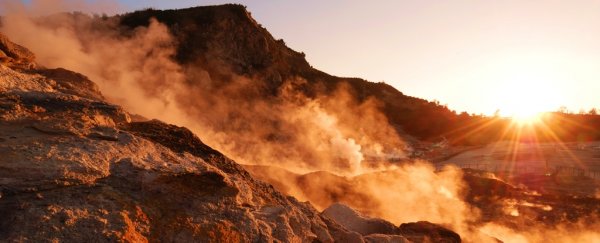It's been almost 500 years since Italy's Campi Flegrei let loose its fiery wrath, but new evidence reveals the ancient supervolcano – the home of Vulcan, the Roman god of fire – may be stirring from its long sleep.
For the 1.5 million residents of the Naple region who live in the shadow of the giant caldera system, there's no immediate danger of an eruption. But the findings nonetheless suggest Campi Flegrei may have embarked upon a new magma cycle that poses ultimately hellish and devastating consequences.
"We propose that the subvolcanic plumbing system at Campi Flegrei is currently entering a new build-up phase, potentially culminating, at some undetermined point in the future, in a large volume eruption," a team of researchers explain in a new paper.
The scientists, led by volcanologist Francesca Forni from Nanyang Technological University in Singapore, examined 23 eruptions from Campi Flegrei's chequered history.
The most recent of these, an eight-day eruption in 1538, may have been powerful enough to birth a new mountain – the aptly named Monte Nuovo – but was a comparatively minor bang in Flegrei's rap sheet.
The two most notable events – the Campanian Ignimbrite eruption, occurring some 39,000 years ago, and the later Neapolitan Yellow Tuff (NYT) eruption – were not minor.
These massive outbursts left large calderas behind them – vacant space freed by explosions of scorching rock that, in the case of the Campanian Ignimbrite eruption, dispersed ash over an estimated area of roughly 3.7 million square kilometres (about 1.4 million square miles).
According to the researchers' chemical analysis of rocks, minerals and glass samples from these two major eruptions – plus from 21 minor eruptions, such as the Monte Nuovo episode – magma conditions under Campi Flegrei could be re-entering a new phase of pressure build-up that precedes potential eruptions.
"Our data reveal that the most recent eruption of Monte Nuovo is characterised by highly differentiated magmas akin to those that fed the pre-caldera activity and the initial phases of the caldera-forming eruptions," the authors write.
"We suggest that this eruption is an expression of a state shift in magma storage conditions, whereby substantial amounts of volatiles start to exsolve in the shallow reservoir."
In other words, the kind of magma that erupted in the Monte Nuovo eruption – which was water-saturated and gassy, being high in CO2 content – has been seen before in Flegrei's volcanic development, in outbursts leading up to the major Campanian Ignimbrite and Neapolitan Yellow Tuff eruptions.
Does that mean we're in a new cycle destined for a devastating supervolcanic eruption? Nobody knows for sure, and even if we were, such an event could potentially be many hundreds or even thousands of years away.
"It can keep these physical and chemical conditions for a long time," co-author Gianfilippo De Astis from Italy's National Institute of Geophysics and Volcanology told The New York Times.
With that in mind, Campi Flegrei's neighbours in Naples should probably be reassured by the findings, if anything. As should the estimated 800 million people around the world who live within 100 kilometres of active volcanoes, because the new findings, scary as they might seem, give us new techniques to understand how magma cycles evolve.
"Understanding what the melt is doing below the surface is so important for helping us forecast what volcanoes might do in the future," volcanologist Janine Krippner from Concord University, who wasn't involved in the research, explained to The Verge.
"These really big eruptions are extremely low probability. But if it does happen, we need to know as much as we can."
The findings are reported in Science Advances.
